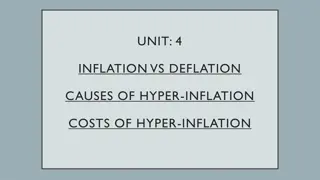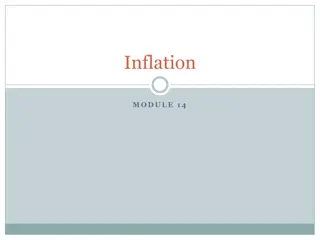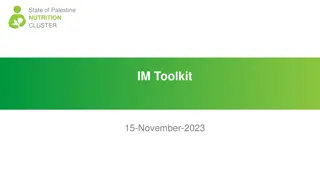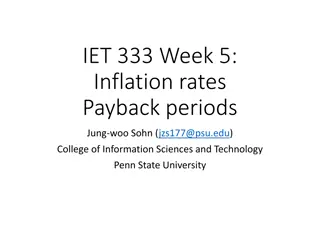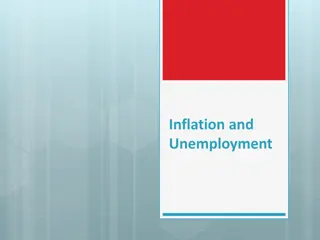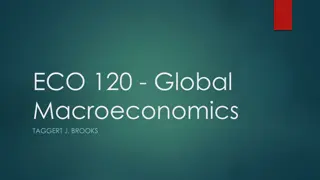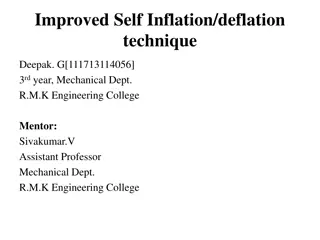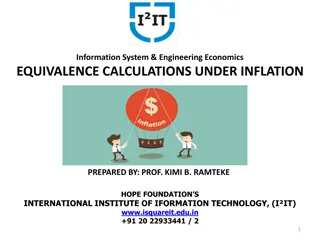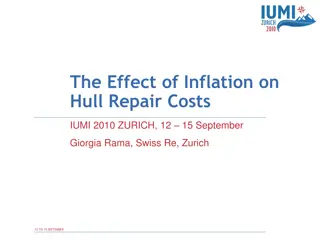Inflation Dynamics in Palestine: Understanding the Economic Drivers
The study examines inflation dynamics in Palestine, focusing on economic drivers such as exports, imports, and investment. It analyzes recent economic developments, population stats, and key indicators like GDP and inflation rates to assess the main determinants of inflation in the region.
Download Presentation

Please find below an Image/Link to download the presentation.
The content on the website is provided AS IS for your information and personal use only. It may not be sold, licensed, or shared on other websites without obtaining consent from the author. Download presentation by click this link. If you encounter any issues during the download, it is possible that the publisher has removed the file from their server.
E N D
Presentation Transcript
Inflation Dynamics During Uncertain Periods: The Case of Palestine By Shaker Sarsour Palestine Monetary Authority 2023 1
Outline Introduction Objective Motivation Recent Economic Developments Economic drivers Exports vs Imports Inflation drivers Methodology Empirical Results Diagnostic tests VECM (short run & long run) Impulse response Conclusion 2
Introduction The Palestinian economy is a small open economy, subjected to many distortions and abnormalities. In active monetary policy, no national currency: (USD, NIS, JOD) This implies: The economy is strongly affected by external shocks, and they are expected to significantly shape its outcomes. 4
Introduction Population: 5.4 million as mid of 2022 - West Bank 3.2 million - Gaza 2.2 million Nominal GDP: USD 18.1 Billions (2021) Imports: USD 10.1 Billions (55.7% of GDP) Exports: USD 3.1 Billions (17.3% of GDP, 31.1% of Imports) Inflation rate: 3.74% (2022) High rate of Unemployment (26.4% of LF, 370 thousands as of 2021) 5
Objective This study seeks to find and assess the main determinant and drivers of inflation in the case of Palestine 6
Recent Economic Developments 7
Main economic indicators 30 25 20 15 10 % 5 0 -5 -10 -15 2017 2018 2019 2020 2021 2022 2017 2018 2019 2020 2021 2022 2017 2018 2019 2020 2021 *2022 Growth Inflation Unemployment Source: PCBS Data for 2022 is preliminary: (growth-forecasts, unemployment Q3,2022) 8
Economic Drivers 15 10 5 Percent 0 2017 2018 2019 2020 2021 -5 -10 -15 -20 Private Consumption Gov't Consumption Investment Net Exports Growth 9
Exports vs Imports 60% Imports, 2021 Imports: USD 10.1 Billions (55.7% of GDP) 50% 40% 30% 55% 20% 20% 10% 15% 7% 2% 0% 0% 100% Israel Asian countries European countries Arab countries Amercas Rest of the world Exports, 2021 80% 60% Exports: USD 3.1 Billions (17.3% of GDP, 31.1% of Imports) 83% 40% 20% 12% 5% 0% Israel Arab world Rest of the world 10
Main derivers of cost of imports in Palestine Factor Impact Outcome Primary commodity prices Energy. Food Inflation in trading partners (mainly) Israel Cost of Imports Jordan Turkey China Exchange rate Appreciation of USD Depreciation of NIS 12
Methodology 13
Methodology The paper utilized a vector error correction (VECM) approach ? ? ??= ? ? + ? ?? ?+ ? ?? ?+ ? ??+ ?? ?=? yt: Inflation rate in Palestine xt : A set of stationary exogenous variables including cost of import (CIM), world food prices (WFP) and consumption level (TC) zt-1 :The first difference of the variables in the model. W: The set of deterministic variables (constant, trend and seasonal dummies) ? : Error correction term (speed of adjustment), where variables in the system adjust to restore a long run equilibrium Used quarterly data from Palestine Bureau of Statistics (PCBS) Period 2000Q1 2022Q2. 14
Cost of imports ? ????= ?? ? ?? ? ? ?=? ???? CIM: Cost of imports expressed in domestic currency (assumed NIS), J: Number of trading partners to Palestine, S: Domestic exchange rate, Sj: Exchange rate of j trading partner, CPIj: CPI in j trading partner country. Wj: Weight of imports from j trading partner. 15
Consumer price index vs other factors Consumer price index in Palestine Cost of imports index 4.8 4.8 4.7 4.7 4.6 4.6 4.5 4.5 4.4 4.4 4.3 4.2 4.3 00 02 04 06 08 10 12 14 16 18 20 22 00 02 04 06 08 10 12 14 16 18 20 22 Total consumption index World food price index 5.2 5.2 5.0 5.0 4.8 4.8 4.6 4.6 4.4 4.4 4.2 4.2 4.0 4.0 3.8 3.8 00 02 04 06 08 10 12 14 16 18 20 22 00 02 04 06 08 10 12 14 16 18 20 22 Source: Calculations based on several data from PCBS, IMF, Bank of Israel and PMA. All variables are in logarithm. 17
Diagnostic tests ADF test indicate that all variables are I(1) H0: There is a unit root for the series (i.e. series is non-stationary) Ha: There is no unit root for the series (i.e. series is stationary) Cointegration test indicate a presence of one cointegrating equation Number of lags = 2 (AIC, HQ criterion) 18
GRANGERCAUSALITYTEST Observations F-Statistic Prob. LCIM does not Granger Cause LCPI 4.436 0.006 87 LCPI does not Granger Cause LCIM 2.349 0.079 LTC does not Granger Cause LCPI 0.791 0.502 87 LCPI does not Granger Cause LTC 5.134 0.003 LWFP does not Granger Cause LCPI 3.259 0.026 87 LCPI does not Granger Cause LWFP 0.296 0.828 LTC does not Granger Cause LCIM 0.788 0.504 87 LCIM does not Granger Cause LTC 6.506 0.001 LWFP does not Granger Cause LTC 2.774 0.047 87 LTC does not Granger Cause LWFP 0.279 0.841 19
RESULTSFROM VECM Long run relationship LCPI(-1) LCIM(-1) LTC(-1) LWFP(-1) Trend Constant Short run relationship D(LCPI(-1)) D(LCPI(-2)) D(LCIM(-1)) D(LCIM(-2)) D(LTC(-1)) D(LTC(-2)) D(LWFP(-1)) D(LWFP(-2)) Dummy Constant @TREND Error Correction Term (ECTt-1) coefficients 1.000 -1.245** -0.251** 0.083** 0.001 1.904 Standard errors t-statistic -0.157 -0.053 -0.041 -7.930 -4.733 2.042 0.059 -0.132 0.305** 0.000 0.010 0.004 0.035** 0.017 0.007** 0.009** 0.000** -0.079* -0.125 -0.115 -0.103 -0.124 -0.018 -0.017 -0.018 -0.018 -0.002 -0.002 0.000 -0.052 0.469 -1.151 2.950 0.003 0.575 0.212 1.914 0.974 2.826 3.738 -3.122 -1.522 20
VECM RESULTSSHORT RUN ????? = 0.079 ???? 1+ 0.059 ????? 1 0.132 ????? 2+ 0.305 ????? 1+ 0.000 ????? 2 + +0.01 ???? 1+ 0.004 ???? 2+ 0.035 ????? 1+ 0.017 ????? 2+ 0.007??? 0.000????? + 0.009 Cost of import is the most significant and influential variable, where price levels in Palestine will increase, on average, by almost 0.31 in the next period, if CIM increased by 1% at time t. World food price has a significant and positive impact on the Palestinian price level, an increased by 1% at time t, then the price level in Palestine will increase by an average of almost 0.04% next period. Total Consumption has a positive but insignificant coefficient onto the Palestinian price level during the short run. 21
VECM RESULTSLONG RUN Cost of import: if CIM increases by 1% at time t, this will lead to an increment in the Palestinian price level by almost 1.24%, on average. Total Consumption: if TC increased by 1% then price level will increase by an average of 0.25%. World food prices: have a negative impact on the price level in the long run, where increasing this variable by 1% will lead to a decline in price level by almost 0.08% on average. This result might be due to the fact that increasing world food prices will, at the first round, lead to an increment in cost during the short term, this will, in turn, negatively affects the level of domestic demand and the purchasing power of individuals; which expected to affect price levels negatively in the long run. 22
Conclusion 23
Prices in Palestine are mainly determined by exogenous variables Cost of import and world food prices has a positive and significant impact on the Palestinian price level during both the short run and long run. Cost of import, is mainly, determined by Israeli monetary policy, since it is the largest trading partner to Palestine, almost 55% of imports are coming from Israel during the period 2017 2021, and almost 84% of Palestinian exports are going to it. Consumption level (i.e. domestic demand) has a significant impact on the domestic price level during long run , while it does not have a significant effect during the short run. Overall, most of inflation in Palestine is imported from abroad, and it is highly and significantly affected by external factors, while it is moderately affected by the domestic factors. Recommendation: policy makers should intervene in the market and monitor price levels to prevent manipulation. subsides prices of necessary commodities, mainly during turmoil periods, to mitigate the impact of different external shocks. 24
Thank You 25







